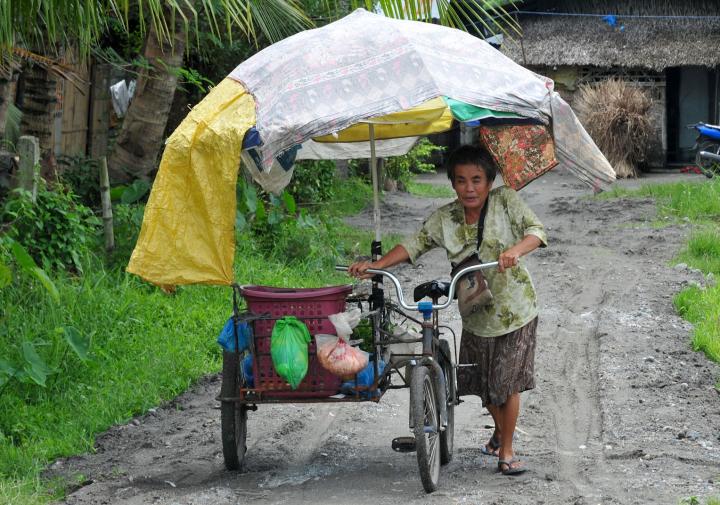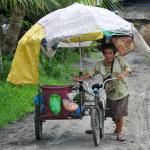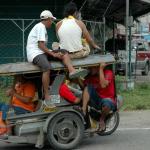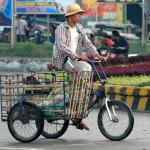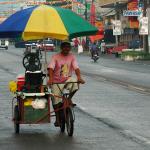Creative Conveyance
People and goods will always need to get from one location to another, so transportation touches everybody in the Philippines. In all aspects of their daily lives, for the general public wheels are the major form of conveyance, the possibility of driving to any destination provides the community with access to friends, family, goods, services, recreation, work and for a legion of venturous and hardworking Filipinos a great opportunity to earn a few pesos. Being on the road also means spending money, and that is not available for everyone, but the rank and file in this country is well known for their ingenuity and creativity, sometimes it seems they can make anything out of nothing. Whether for the transportation of human beings, animals or freight, there is always a practical solution for everything.
For many it is not important how their vehicle looks, all that matters is a carriage that works and as long as it serves its purpose, others are transforming them into fancily decorated objects. So it is no surprise that the most weird and unusual looking two-, three and four wheeled contraptions can be seen on the roads and in every nook in the cities and provinces, some of them are just odd enough to raise an eyebrow and amuse the spectator. These driving doohickeys come in a plethora of colours, shapes and sizes, well made and poorly constructed, motorized, pedal- or manpowered, factory built or homemade, cheap and high-priced assembled. Fabricated from new and second hand materials, spare parts and accessories from various brands, safe and unsafe, used for commercial or private use, all of them not being restricted to any weight, wideness or height and unique in their own way.
A real showcase of Filipino ingenuity and one of the ubiquitous forms of public transportation is undoubtedly the fossil-fuel powered tricycle, these noisy three-wheelers are the most convenient and common way to go around and mainly used to ferry passengers to just about anywhere. Normally, they have a seating capacity of 5 or 6 passengers including the driver but it can fit many more people than it appears at first glance. Passenger in search for a cheap ride are sitting on the bench of the side-cab, on the floor, behind the driver, on the luggage rack, hanging at the rear or sides of the sidecar and If there isn't enough room they hold? on to the back or even sit on top. Next to transferring people from one place to another many tricycles are adapted for hauling animals like pigs, sheep and goats. A single-wheel metal frame that partially or completely encloses the animal is attached to the motorcycle; this type of construction is also used for carrying gas tanks, charcoal, recyclable junk and crates of beer and soft drinks. However, the Filipino people are quite capable to improvise when they don't have the means necessary to get where they want to go, so this one or two stroke steel working horse also serves for the transportation of passengers, giving it an entire new meaning to the word people transportation. The flat sidecar can accommodate up to 4 or 5 persons, just the perfect cruising apparatus for a low budget outing with the whole family or a trip to the shopping mall.
Itinerant handlers employ a wide array of locomotion and the vendors pulling and pushing two-wheeled carts or roving hawkers with bicycles, selling all kinds of goods on the streets are a common sight. Independent street peddlers make daily life less expensive and much easier; they play an important role in keeping the cycle of the local economy in motion. Most of them are moving their mobile shop late in the afternoon to their everyday selling points or are plying a regular daily route. A familiar appearance around town is the scissors-and-knife sharpener, going from place to place and house to house, looking for customers on a pedal powered sharpening machine, office and workshop in one. A majority of the characteristic three-wheeled bike vendors are selling their food prepared on the spot and are catering their client's hungry bellies with ice cream, fish balls, popcorn, vegetables, bread and much more. The tireless, always moving food jobbers on their small, eco-friendly carriers surely know how to bring big smiles on many faces. These wandering meals on wheels are fitted with an overhead umbrella or canopy made out of plastic, canvas, rags or even cardboard, providing shade from the sun, but giving little protection when it is raining or storming. Every movable mini mart is converted and adapted to the kind of product that is sold and perfectly fitted with the appropriate essentials. Metal, wooden, plastic or Styrofoam boxes and bamboo baskets for storage are mounted in various ways. Each small scale street-entrepreneur has a different way of announcing their presence, continually repeating the same sound while passing through, whistles, loudspeakers, cow bells, ting-a-ling bells and bicycle horns are used to let potential customers know they are approaching. When such jingling and jangling, clanging or honking gadgets are not available, their own voice, with or without a megaphone, is used to shout out what kind of merchandise they have to sell.
When it comes to getting from A to B, the creativity and adaptability of the Filipinos has no limits. They have an excellent ability to improvise and make cleverly designed and functional creations which are not only a blessing for the owner or operator for earning their livelihood but a captivating addition to the numerous phenomena and the fascinating culture of the Philippines as well.
 ThingsAsian
ThingsAsian